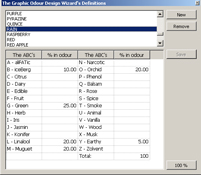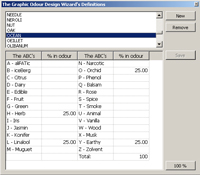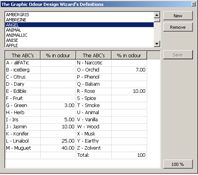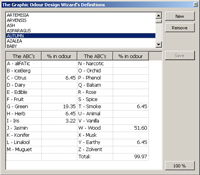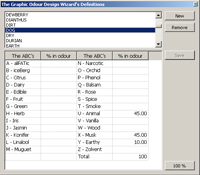The Perfumer's
Workbook® | |
Inside The Perfumer's Workbook®
Definitions
How would you describe the smell of white cotton?
So you have an idea for a perfume. All you need is to have someone make it for you. And all they need from you, for a starting point, is a description of the smell you want. Are you going to tell them you want a perfume that smells like something that has no smell?
Perfume, art, and music are closely related. We use musical analogies to describe perfume. And for the artist within us, we use visual images to describe a desired smells. But a visual image has no smell.
| Study your ABC's. Then look at how they can be used to describe these smells. |
| The Perfumer's Workbook fragrance creation software was developed by perfumer Stephen V. Dowthwaite, founder of PerfumersWorld and is included as part of the PerfumersWorld Foundation Course or can be purchased separately for instant download.
Also available: The Perfumer's Workbook Professional Edition, starting at $5,000. Installation and on-site training available. Inquire. |
You may say certain visual images evoke certain smells. But those visual images may not evoke the same smells for me as they do for you.
Part of the mechanics of getting a perfume made -- the mechanics of the dialog between client and perfumer -- involves finding a common language that will provide clarity in communications.
One of the tools in The Perfumer's Workbook is a library of scent definitions -- words we commonly use to describe a fragrance translated into simple scent formulas easy enough to make yourself. Then you can test to see if the scents indeed are correct for the words you are using.
Because this table of definitions is part of The Perfumer's Workbook which itself is part of the PerfumersWorld perfumery courses, words are defined using the "ABC's of Perfumery."
The "ABC's of Perfumery," developed by Stephen V. Dowthwaite, founder of PerfumersWorld, is a system in which about 95 percent of everything we can smell (or imagine smelling) can be assigned to one of 26 primary odor groups.
These groups are generalizations but they are not abstractions. PerfumersWorld has matched each of these A to Z odor groups with an aroma base which defines that group.
Complex odors (most odors are complex) are represented by one (upper case) letter -- A to Z -- for their primary smell and additional (lower case) letters as required for their secondary smells.
You can read description of these 26 basic smells to get some idea of what they are, but it is difficult or impossible to use them in communications without having experienced each smell itself, right out of the bottle, so to speak.
Bottles of each of these 26 smells are packaged with the PerfumersWorld Foundation Course K26 materials kit. This kit also includes a copy of The Perfumer's Workbook.
Using The Perfumer's Workbook you can discover how words ("dog," "Christmas," "cookies," "cucumber") can be described within the ABC's of Perfumery, those 26 aroma bases that are part of the K26 kit.
The Perfumer's Workbook "definitions" list includes over 450 words and phrases (some suggesting names of famous perfumes) that are "defined" in terms of the ABC's. The screenshots at the left show some examples.
Sharpen your communications!
These definitions are important first because they give you a common language with a perfumer. Now, rather than saying you want your perfume to carry the aroma of "cucumber" you can specify you want 0.58% Fruit ("F"), 58.48% Green ("G"), 17.54% Iris ("I"), 5.85% Muguet ("M"), and 17.54& Earthy ("Y", as in "yeast") -- and, using your materials from the K26 kit, you can mix up your own sample of this formula to confirm that it is indeed your idea of what "cucumber" should small like. And, if it's not, you can adjust the formula -- usually just the quantities of each material -- to achieve the cucumber smell you want.
So now you don't just tell the perfumer "cucumber." You give him or her a formula for the cucumber smell you want.
A great learning tool
The second great importance of this "definitions" table is that it is an excellent learning tool. All 450 plus words and phrases are defined within the boundaries of 26 aroma materials which you can have on your desk. Each definition is given in terms of a simple formula (again, look at the screenshots) and you can make up your own samples of each of these formulas so that you are matching words to smells.
As you go through the list, you're going to find inspiration -- ideas for perfumes you had never thought of before or never thought you could make. But now you can see, smell, and explore the building blocks that will go into them. This is a tremendous stimulator for new perfume ideas -- ideas and perfumes that will be yours!
If perfume is your interest, the PerfumersWorld Foundation Course with the K26 materials kit and The Perfumer's Workbook software will open new worlds for you.
Order this fine product directly from our friends at PerfumersWorld
Homemade perfumes generally lack commercial value, regardless of how wonderful they may be, because their creators fail to record how their perfumes were made. To profit from a perfume, to sell it, to sell the rights to it, or have somebody sell it for you, you must be able to make more of it. To make more you need the formula, the record of how the perfume was made: what materials were used and how much of each material was used. While the formula is nothing more than a recipe, a simple piece of paper, it is the key to unlocking your perfume's commercial potential. With the formula in your hand you have the ability to make a few dozen bottles more or, like the celebrities, tens of thousands of bottles. How to create an international production formula for your homemade perfume is a guide to getting you started on the right foot, correctly documenting everything you do as you are doing it, and then using these notes with some basic mathematics to write a simple, accurate, universal formula for your perfume. Writing formulas for your perfumes can change the way you think about them. With your formulas in hand your creations are no longer "here today, gone tomorrow." Now, thanks to your library of formulas, your perfumes become immortal!
While much is written about perfume – the beautiful fragrances... the beautiful bottles – little is available on the "mechanics" of perfume production – the steps that take place on the "factory floor" where a beautiful vision is turned into a finished product, a "ready to sell" perfume. Now you can experience all of these steps, hands on, by making just one quart of your own perfume. If you follow each chapter and do what you are instructed to do, you will end up with from 8 to 64 bottles of your own perfume, depending on the capacity of the bottles you select. Along this "insiders journey," each step is profusely illustrated with professional color photographs and you'll learn — • Exactly what alcohol you'll need and where to get it • Why you'll want (just a little!) water in your perfume • What type bottles you'll need and why you cannot use others • Why you will use a spray and not a cap • How to fill and seal your bottles • How to label your bottles with the correct information so they will be legal for sale • How to select a name for your perfume that will allow you to acquire powerful trademark rights free. If you are a developer of scents you are encouraged to use one of your own for this project. If you are not a scent creator yourself you'll learn how to get a fragrance oil that is exactly right for this project. Online sources are given for all required supplies and materials. Nothing can hold you back from starting your project immediately!
Perfume is famous for the markup it can achieve, even for a middle market fragrance. While "everybody knows" that perfume costs next to nothing to make (not completely true) the making of it is often considered an esoteric secret. "Creating Your Own Perfume With A 1700 Percent Markup!" details how a 3-person company with no experience created their own fragrance in response to a marketing opportunity that was too good to pass up. The book explains exactly what was done to create a fragrance for that opportunity but it is far more than a history of the author's project. "Creating Your Own Perfume With A 1700 Percent Markup!" lays out every step in the process of creating your own perfume, either as a do-it-yourself project – and without the benefit of automated equipment some compromises and workarounds are required – or full bore professional production under your supervision. Either way you will be producing a quality fragrance at a remarkably low cost. Do you have a marketing opportunity that would be wildly profitable if only you could obtain your fragrance at a ridiculously low cost? "Creating Your Own Perfume With A 1700 Percent Markup!" is the guide you need to do it.
A really great name, a special name that is just right for a particular perfume or perfume marketer (or entrepreneur with money to invest!) can be worth a ton of money. But few individuals with great ideas ever manage to cash in on those brilliant ideas. Instead they wait while others "discover" their idea, acquire legal rights to it and make all the money while they are left out in the cold without a penny having been earned for what was once THEIR idea.
If you are struggling to name your perfume and are looking for a name that will have real value, "Naming Your Perfume And Protecting Your Name" will help you weed out low value names and point you to names that have better marketing value plus the potential to become valuable assets in themselves.
If you have a great name you want to protect but no fragrance, "Naming Your Perfume And Protecting Your Name" will guide you through the simple steps you must take to acquire a legal right to that name before someone else grabs it! Best of all, "Naming Your Perfume And Protecting Your Name" shows you how to gain strong legal protection for your name without a lawyer and without spending more than pocket change.
Never had an idea for a product name? Never thought much about perfume? "Naming Your Perfume And Protecting Your Name" may stimulate your interest in a whole new game that, when played well, can make you lots of money without your having to leave the comfort of your home office.
You can build a perfume business of your own using this business plan as a guide. By following its detailed strategy you learn to identify motivated groups of potential perfume buyers. Members of these groups are near the tipping point of desire for a new perfume. You don't know these people and they don't know you but you know a marketer they trust, one who does not currently sell perfume and might never think of selling perfume were it not for your approach. Here is where you step in with a professional plan, promotion, and perfume to take advantage of this ripe opportunity for mutual profit. Before your first promotion has peaked, you will already be developing a relationship with your next marketing partner. Following this plan, you will gain more and more profit with each new marketing partnership.
Now when you make your own perfume you can make it fully "commercial" meaning you will be creating a product ready for regular, continuous sales to friends, relatives, and the public! If the fragrance you've made has already won praise, why not share it with others? Some might pay you for it and want it for their web stores or retail boutiques! Creating your own perfume from dropper bottles: Methods, mechanics, and mathematics guides you through steps that can turn your hobby project into a perfume business. Discover how close you are now and how little more you must do to take what you made with essential oils and dropper bottles into a business of your own! For an introduction to this book, watch this video.
When you name a perfume you create a valuable asset – the name itself. To sell your perfume you want the most effective name possible. But a good name can have value beyond the edge it gives your sales. In naming your fragrance you are creating a trademark and a trademark can have value independent of the product. The value of that trademark can vary. Much depends on how well, in naming your perfume, you follow the trademark "rules." How To Create A More Valuable Name For Your Perfume first helps you develop a name that will be effective in selling your perfume. It then prods you to make use of certain techniques that can turn a good name into a great trademark, strong and valuable. If you have questions about how to protect a name, How To Create A More Valuable Name For Your Perfume will answer many such as:
- Can you protect your name yourself or do you need a lawyer?
- Can you register a trademark without a lawyer?
- What does it cost to register a trademark?
- How do I enforce the rights I have established?
How To Create A More Valuable Name For Your Perfume covers both state, federal, and international protection.
For article updates, etc., add your name to Phil's mailing list.


Philip Goutell
Lightyears, Inc.

